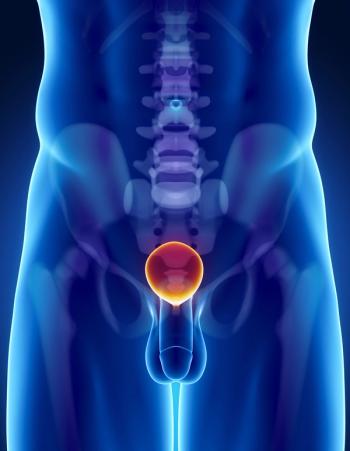
Stereotactic Body Radiotherapy Is a Viable Option for Pulmonary-Impaired NSCLC
Patients with early stage non–small cell lung cancer and impaired pulmonary function could potentially benefit from treatment with stereotactic body radiotherapy.
Treatment with stereotactic body radiotherapy (SBRT) appears to be a reasonable option for patients with impaired pulmonary function and early-stage non–small cell lung cancer who are candidates for surgery, according to a study published in the Asia Pacific Journal of Clinical Oncology.
For patients in the surgery group vs SBRT group, the 3-year overall survival (OS) rate was 76% (95% CI, 62%-85%) vs 80% (95% CI, 66%-88%) and the 5-year rate was 68% (95% CI, 54%-79%) vs 57% (95% CI, 42%-70%; P = 0.20). Additionally, the 3-year cancer-specific survival rate was 85% (95% CI, 73%-92%) vs 90% (95% CI, 77%-96%) and the 5-year rate was 79% (95% CI, 65%-88%) vs 76% (95% CI, 60%-87%; P = .73) in both respective groups. Lastly, the 3-year and 5-year disease-free survival (DFS) rates were 67% (95% CI, 53%-78%) vs 49% (95% CI, 35%-61%) and 61% (95% CI, 47%-72%) vs 37% (95% CI, 24%-50%; P = .028) in the surgery and SBRT cohorts, respectively. Patients had a surgical mortality rate of 4.0%, but there no treatment-related deaths were reported in the SBRT arm.
A total of 116 patients were enrolled in the trial, 61 of whom were in the surgery group and 55 were in the SBRT group. Patients had a median age of 73 years in the surgery group and 76 years in the SBRT group (P <.001). Performance status (P = .014) and Charlson comorbidity index (P = .001) were significantly lower in the surgery group. A lobectomy was performed in 43, 7, and 11 patients in the surgery group underwent lobectomy, sublobar resection, and wedge resection.
To avoid bias, propensity score matching was used, to identify 25 patients from each group, who underwent lobectomy (n = 17), sublobar resection (n = 3), and wedge resection (n = 5). In this group, the median age was 75 years for the surgery group and 74 years from the SBRT group (P = .67).
The median pretreatment forced expiratory volume in 1 second (FEV1) was 58% in the surgery group and 56% in the SBRT group (P = .66). The predictive postoperative FEV1 was 45% for both groups (P = .91). After propensity score matching, 17 patients had a lobectomy, 3 had a sublobar resection, and 5 had a wedge resection.
A multivariate analysis found that higher performance status was that only significant factor associated with a shorter OS (HR, 1.7; 95% CI, 1.1-2.6; P = .021). Notably, treatment methods including surgery or SBRT were not associated with OS (HR, 1.3; 95% CI, 0.67-2.4; P = .45).
A total of 18 patients who underwent lobectomy and limited surgery, 14 who underwent sublobar resection, and 8 who underwent wedge resection died. Those who underwent a lobectomy had a slightly shorter OS in the multivariate analysis (HR, 3.0; 95% CI, 0.88-10; P = .080). After surgery, similar results were observed in those who received limited surgery (HR, 1.1; 95% CI, 0.46-2.5; P = .87) and lobectomy vs SBRT (HR, 1.1; 95% CI, 0.76-1.7; P = .54).
In the matched group, follow-up times were 56 and 60 months in the surgery and SBRT groups, respectively. At 3-years the OS rate was 74% (95% CI, 52%–88%) vs 80% (95% CI, 58%–91%), cancer-specific survival was 87% (95% CI, 64%–96%) vs 92% (95% CI, 71%–98%), and DFS was 57% (95% CI, 35%–74%) vs 56% (95% CI, 35%–73%) it the surgery and SBRT groups, respectively. At 5-years, the OS was 60% (95% CI, 37%–77%) vs 63% (95% CI, 41%–79%), the cancer-specific survival was 76% (95% CI, 51%–89%) vs 81% (95% CI, 56%–93%), and the DFS was 52% (95% CI, 30%–70%) vs 48% (95% CI, 28%–66%), in the surgery and SBRT groups, respectively.
During lobectomy, 1 patient in the matched group died of a massive hemorrhage. Grade 3 treatment-related adverse effects (TRAEs) included 1 patient having prolonged air leakage. No patients had grade 4 TRAEs. TRAEs of grade 2 or higher were observed with 2 patients who had grade 2 radiation pneumonitis, and 2 patients who had grade 2 rib fracture.
Reference
Tomita N, Okuda K, Kita N, et al. Role of stereotactic body radiotherapy for early-stage non-small-cell lung cancer in patients borderline for surgery due to impaired pulmonary function. Asia Pac J Clin Oncol. Published Online January 30, 2022. doi:10.1111/ajco.13731
Newsletter
Stay up to date on recent advances in the multidisciplinary approach to cancer.


















































































